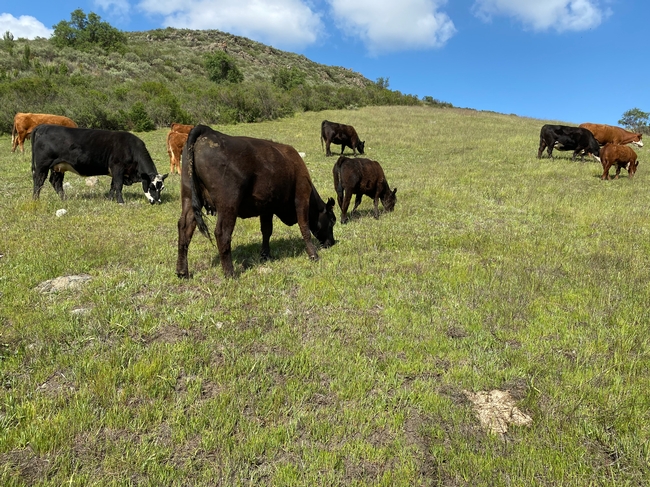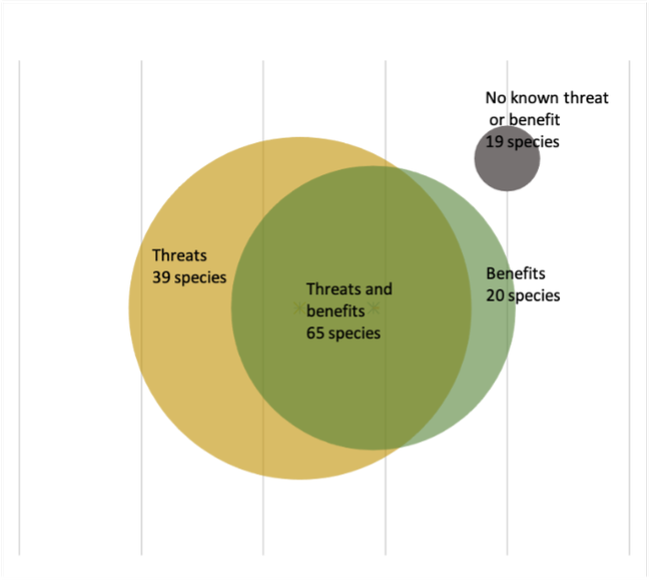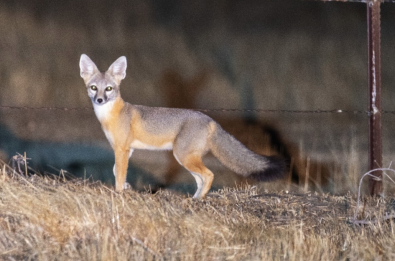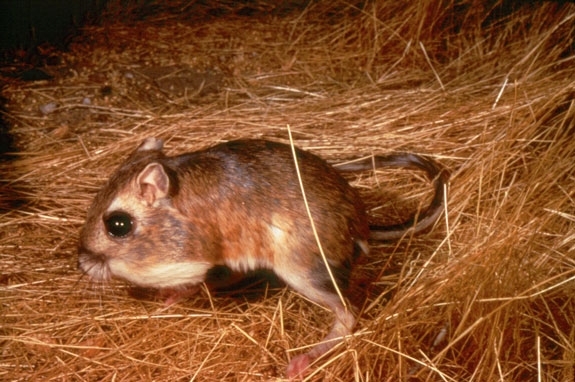Well-managed grazing can control non-native plants and maintain habitat and ecosystems to support a variety of species
Research recently published in the journal Sustainability documents a role for livestock grazing to support the conservation of imperiled plant and animal species in California.
Livestock grazing occurs in every county except San Francisco and is the single greatest land use in California. Grazing livestock, primarily beef cattle, often share lands with threatened and endangered species. California has more federally listed threatened and endangered species (287 plants and animals) than any other state in the continental US. While this is a result of our state's varied climate, soils and topography, the threat to diversity is predominantly from habitat loss due to land use change. Housing and urban development, solar and wind farms, cultivated agriculture, and public works projects such as reservoirs, roads and high-speed rail all result in habitat loss for some native species, many of which are threatened or endangered. Alternatively, maintaining ranching, or managed grazing for beef cattle production, can support the conservation of many threatened and endangered species in California.
A review of United States Fish and Wildlife Service (USFWS) listing documents for threatened and endangered species in California provided an opportunity to understand the relationship between livestock grazing and species conservation. Based on USFWS documents, 51%, or 143, of the federally listed animal and plant species are found in habitats with grazing. Livestock grazing is a stated threat to 73% (104) of the species sharing habitat with livestock, but 59% (85) of the species are said to be positively influenced, with considerable overlap between species both threatened and benefitting from grazing. The fact that USFWS identifies grazing as both a threat and a benefit to many species indicates that how grazing is done matters.
While species may be negatively impacted by grazing that is excessive or unmanaged, managed grazing can control vegetation and maintain habitat structure and ecosystem function to support a variety of species. Controlling non-native species, mostly non-native annual plants, is the most frequent reason that grazing benefits both federally listed flowering plant and animal species in California. In fact, 89% of species positively impacted by livestock grazing benefit from control of non-native species. For example, controlling non-native annual grasses favors native forb or broad-leaf plant populations that support the conservation of 10 different butterfly species and one moth species which rely on forbs for nectar and larvae food.
In addition to controlling non-native plants, grazing benefits some listed species by controlling vegetation, including thatch or dead plants that alter habitat. In the grasslands and shrublands of the San Joaquin Valley, maintaining habitat with sparse vegetation supports a variety of listed species, including the Kern mallow plant (Eremalche parryi ssp. Kernesis), the blunt-nosed leopard lizard (Gambelia silus), the giant kangaroo rat (Diposdomys ingens), and the San Joaquin kit fox (Vulpes macrotis). For the small ground-dwelling animals, annual grass and thatch can create an impenetrable thicket. For the larger native animals like the San Joaquin kit fox, taller, dense vegetation can obscure the visibility of predators. Habitat with sparse vegetation is also necessary for listed plant and animal species in coastal grasslands, including the Santa Cruz tarplant (Holocarpha macradenia) and Ohlone tiger beetle (Cicindela ohlone).
Some species (plants, insects and a reptile) benefit from grazing that controls vegetation associated with air pollution. The USFWS cites research that shows air pollution, specifically dry atmospheric nitrogen deposition, creates a fertilizer load that alters plant communities and habitat, and livestock grazing can restore or maintain habitat by removing excess vegetation and nitrogen. The control of vegetation through grazing is also associated with maintaining grasslands by preventing succession or invasion by brush to benefit some animal and plant species. For listed plants like the Western Lily (Lilium occidentale) that are threatened by loss of grassland, the USFWS has stated that the benefits of grazing seem to outweigh the potential threat to these plants being grazed or trampled.
Within aquatic habitats, species benefitting from grazing, which includes flowering plants, amphibians and invertebrates, are primarily found in temporary or vernal pools, where livestock help maintain an adequate inundation period. Listing documents for species in temporary pools cite research that describes increased grass cover in and around ungrazed vernal pools leading to increased evapotranspiration and decreased pond duration. Other benefits stated for listed species in aquatic habitats include two animal species that benefit from the presence and maintenance of stock ponds associated with livestock grazing.
This review of the USFWS listings documents concludes that many federally listed species in California are conservation reliant, requiring continued interventions to support their lifecycle or maintenance of habitat, and that sharing land with livestock grazing is an important conservation strategy. Species benefiting from grazing are often threatened by the loss or cessation for grazing. Most, if not all, ecosystems on the planet have been altered by land use and other anthropogenic effects. Threats to biodiversity stemming from pervasive non-native species, climate change, and the disruption of essential ecosystem processes and disturbance regimes are not typically overcome simply by preserving land, improving regulatory protections, and removing threats. Livestock grazing is perhaps the only ongoing land use that can be feasibly manipulated to manage vegetation and habitats at the landscape scale.
To read the journal article “Rangeland Land-Sharing, Livestock Grazing's Role in the Conservation of Imperiled Species,” visit https://www.mdpi.com/2071-1050/13/8/4466.
To learn more about livestock grazing and beef cattle production in California, see the "Understanding Working Rangelands" fact sheet series:
- Bay Area Ranching Heritage: A Continuing Legacy
https://anrcatalog.ucanr.edu/pdf/8528.pdf
- Cattle, Sheep, Goats, and Horses: What's the Difference for Working Rangelands
https://anrcatalog.ucanr.edu/pdf/8524.pdf
- Ranching Infrastructure: Tools for Healthy Grasslands, Livestock, and Ranchers
https://anrcatalog.ucanr.edu/pdf/8561.pdf
- Sharing Open Space: What to Expect for Grazing Livestock
https://anrcatalog.ucanr.edu/pdf/8516.pdf
- Caring for Cattle to Provide Safe and Wholesome Meat
https://anrcatalog.ucanr.edu/pdf/8530.pdf
- Cows Need Water, Too: Water Sources, Wetlands, and Riparian Areas
https://anrcatalog.ucanr.edu/pdf/8525.pdf
- Grazing Systems Management
https://anrcatalog.ucanr.edu/pdf/8529.pdf
Author - County Director/ Livestock and Natural Resources Advisor, San Francisco Bay Area



